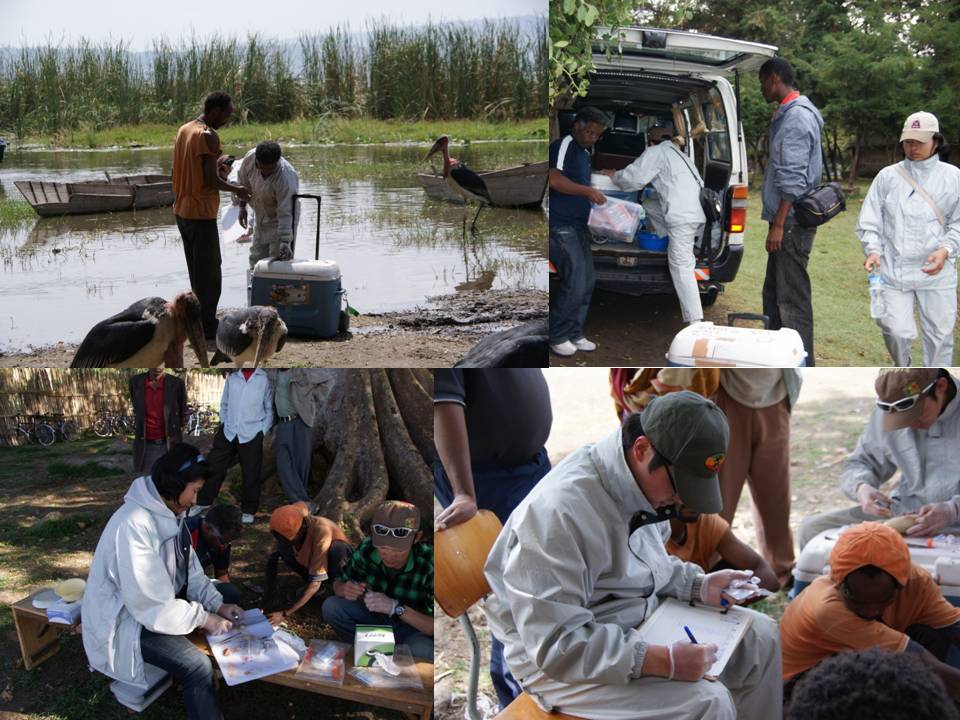Report of Ethiopian research trip activity
Report of Ethiopian research trip activity – 2012
Yared B. Yohannes, Laboratory of Toxicology, Graduate School of Veterinary Medicine, Hokkaido University, Sapporo, Japan
Project period: From May 05, 2012 – June 06, 2012
Introduction
Persistent organic pesticides (POPs) and heavy metals are among biosphere pollutants of global concern due to their environmental persistence, ability to bioaccumulate and magnify in the food chain and chronic toxicity. In aquatic environments, fish are exposed to these environmental pollutants either from water via gills or/and from the diet. Henceforth, fish are the most suitable indicators for the burden of aquatic pollution monitoring since they concentrate pollutants in their tissues and enabling the assessment of transfer of pollutants through the trophic web.
The Ethiopian rift valley region is a densely populated area confined with various agricultural activities. The Valley encompasses seven principal lakes namely Lake Ziway, Abijata, Langano, Shalla, Awassa, Abaya and Chamo. Lake Ziway, a principal source of commercial fishery, is located in an area with high agricultural activities with little soil conservation efforts around the catchment area. Intensive grazing and destructive harvest of vegetation coupled with recent establishments of flower farms in the proximity are probable threats to the lake. Large agricultural intensification, municipal waste discharges are increasing claims on the precious fresh water ecosystem resources and threatens the environment. The objective of this sampling is, therefore, to study bioaccumulation levels of OCPs and heavy metals from Lake Ziway, Ethiopia.
Materials and Methods
Sampling area:
Lake Ziway (7°57’N and 38°45’E; surface area: 490 km2; max. depth: 9m) is a fresh water located 160 km from Addis Ababa which principally originates from the two incoming rivers; The Ketar River and Meki River. It drains toward Lake Abiyata via Bulbula River. The lake has a large littoral zone, containing emergent and submergent vegetation, which provides feeding, and breeding and nursery habitats for fish. It is highly influenced by rural, urban and other economic activities as it is situated to the Ziway town and hinterlands.
Lake Ziway is well known for its aquatic bird life and other aquatic animals and plants. The importance of the lake as a wet land bird habitat is immense. According to a bird survey (1995) there are various species of water fowls in and outside the Lake. The most common being Great-White Pelican, Marabou Stork, Fulvous Whistling Duck, Cormorants and others. In this time, I collected four bird species: Leptoptilos crumeniferus, Pelecanus onocrotalus, Scopus umbretta, and Threskiornis aethiopicus. This sampling has been permitted by the Ethiopian Wildlife Authority.

Result and discussion
Preliminary result on the levels of organochlorine pesticides (OCPs) from five fish species (Tilapia zilli, Carp spp, Oreochromis niloticus, Barbus intermedius and Clarias gariepinus), with two trophic levels from Lake Ziway showed different accumulation behavior among the studied fish species. The main OCPs detected in this study were DDTs, HCHs, heptachlor-epoxides and chlordanes; with the former is the most abundant.
The possible reasons for the presence of high level of DDTs may be attributed to the run-off and atmospheric deposition from DDT which is used for agricultural and malaria control activities in the area. DDTs were identified from all fish tissue samples and the metabolite p,p’-DDE was accounted for 41 % to 82 % of the total concentrations of the DDTs. Small inputs of DDT was also detected in herbivorous fish species (Tilapia zilli, Carp spp, Oreochromis niloticus).
The study supports the followings phenomena: The carnivorous species are found at high trophic position, indicating they fed at same trophic level. DDTs were the main OCs detected in the fish community which probably came through the local source near the lake. Maximum levels of OCPs were found in Barbus species and C. gariepinus as being found at higher trophic positions, which demonstrates the bioaccumulation trend of persistent organic pollutants like DDTs.
The experience gained from the field study based on animal welfare point of view as well as in vivo study encourages the researchers to visualize further aspects/studies besides to sharing ideas with other researchers. The data obtained from the study will be helpful for the country to establish original baseline data regarding the pollution status of wildlife and provide useful information for further studies and to different government offices and leaders or policy makers like ministry of health and water, wildlife authorities and environmental agencies. Therefore, studies on negative impacts are useful to prevent future damage and restore environmental quality.

